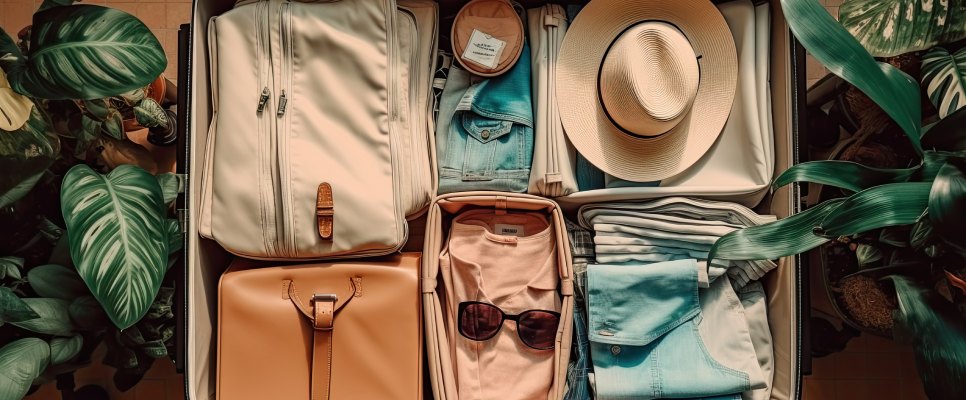
The moment of departure has a way of clarifying everything. If your bag feels like a burden by the time you reach the train station or airport, you probably brought too much. On the other hand, if you realize you’ve forgotten socks, chargers, or a weather-appropriate jacket, you didn’t pack with purpose. For short trips, the art of packing isn’t just convenience. It’s control. When space is limited and time is short, every item must justify its presence.
Pre Packing Considerations
Before any clothes are folded, a few questions need answering. How many nights will you be away? Will you be walking extensively or attending anything formal? and most critically, what will the weather demand of your wardrobe?
Two nights away typically means two full days plus transit time. If one of those days includes hiking or events that require specific gear, those pieces will consume both volume and flexibility. While some travelers trust intuition, checking the forecast the night before departure has proven to be more reliable. Sudden drops in temperature or unexpected rain have a way of revealing poor planning.
Space also depends on transport. Airlines with restrictive carry-on allowances make overpacking both risky and costly. Meanwhile, road trips permit more room but invite clutter. Discipline matters either way.
Essential Clothing Items
The most effective weekend bags follow a compact uniform logic. The 1 2 3 4 5 rule—one outer layer, two shoes, three bottoms, four tops, and five undergarments—has gained traction for good reason. These numbers strike a middle ground between minimalism and preparedness.
Tops should layer well, with one or two pieces offering warmth and one presentable enough for a dinner out. Jeans, leggings, or chinos can span several outfit combinations without feeling redundant. Shoes require particular scrutiny. Limit yourself to one walking pair and, if needed, a second option for dress or weather contingency. Sleepwear and socks are often overlooked but regrettably so. Choose breathable materials that compress easily.
The success of any wardrobe hinges on neutrality. Clothes that cooperate with one another multiply your options without adding weight.
Toiletries and Health Essentials
No matter how light you pack elsewhere, poorly managed toiletries can ruin a bag. Travel-sized bottles are standard, but their utility depends on how well they’re sealed. Leaks from shampoo or lotion can stain everything in close range. Use containers designed for transport and keep them in a zip top bag to insulate the risk.
Essential items include toothpaste, a toothbrush, deodorant, face wash, sunscreen, and skincare basics. For those with particular prescriptions, medications should be packed first, not last. It’s also advisable to bring a few adhesive bandages, pain relief tablets, and a small packet of tissues or wipes.
Those who fly frequently often leave a toiletries kit pre stocked between trips. This removes the need to rebuild the list each time and reduces the chance of forgetting essentials.
Electronics Travel Documents and Miscellaneous Gear
Travel with electronics is nearly universal now, but it’s still easy to make mistakes. Forgetting a phone charger can throw an entire weekend into minor chaos. Include a charging cable and a compact power bank for backup. Headphones, especially noise canceling ones, offer relief during transit.
Your wallet or travel pouch should contain identification, debit or credit cards, and printed or digital copies of any booking confirmations. Screenshots help when service is unavailable. Some travelers prefer to store everything digitally, but redundancy tends to pay off when things go wrong.
A few extra items can also make a difference. A reusable water bottle cuts down on airport and train station purchases. A small notebook, pen, or e-reader adds variety to downtime. If you’re packing snacks, choose things that don’t melt or crumble.
Smart Packing Methods and Preparations
Method matters. Rolling clothes rather than folding them tends to preserve space and reduce wrinkling. Compression cubes can be useful, but only if they don’t encourage overpacking. Place heavier items at the base of the bag and pack shoes along the edges, soles out. Use inside space such as stuffing socks inside shoes to prevent wasted volume.
Weigh your bag ahead of time if flying. Even a couple of pounds over the limit can incur costly fees. Write a packing list a day in advance, then cut it down once. Items that might be used once don’t usually deserve a spot.
Travel Hacks for Carry-on Only Packing

The benefits of flying with a carry on go far beyond simple convenience. No baggage claim wait, no risk of loss, and reduced stress during delays. To make this a reality, multi-functional objects are the key. A sweater that is suitable for day or night, a dress that can be dressed up with sneakers or flats, or a bag that is both a tote and daypack can cut your load in half.
Always keep a toiletry bag handy and place chargers and important documents in one place after every journey. This is handy upon waking and also avoids forgetting them.
Some tourists bring a compact collapsible bag within their primary bag. It may be used as a beach or shopping bag upon arrival, or as an instant solution to carry extra souvenirs or laundry.
Timing and Pre Departure Strategy
Pack in advance, but check details afterwards. Weather conditions can change, and packing in advance might help catch you unawares. Take time to go through all your equipment, confirm bookings, and check check-in times. If you can, plan to reach your point of departure ahead of time. This is not being anxious. It’s an option. Delays or mistakes are easier to handle when you have options rather than racing against time.
Pack accordingly to the space you have. A packed bag does not allow for change. Having one or two gaps intentionally allows you some room to move without losing functionality.
Conclusion
A well-packed bag won’t guarantee a fantastic weekend. But it will prevent most common issues, such as being uncomfortable or running late. Every item must have a purpose for being there, and every pocket must make sense. Short trips require planning. When everything has a place and nothing is forgotten, traveling is less about managing your stuff and more about having a good time.
